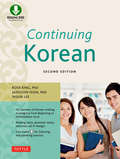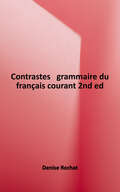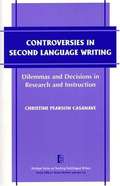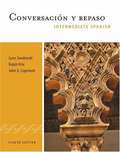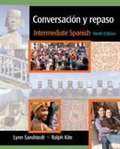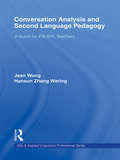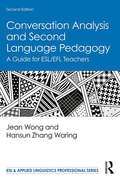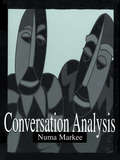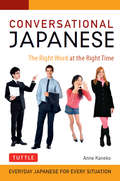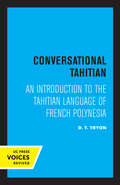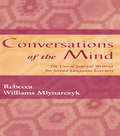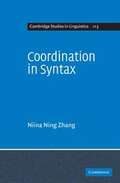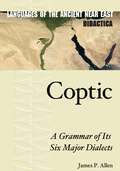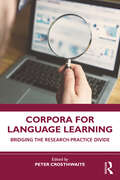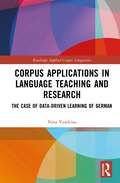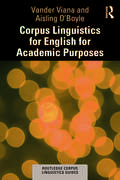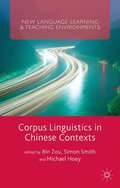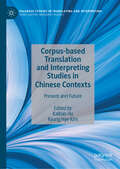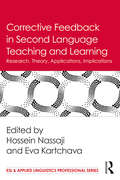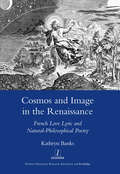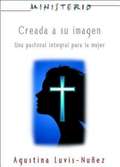- Table View
- List View
Continuing Korean
by Ross King Jaehoon Yeon Insun LeeContinuing Korean is the second volume in Ross King and Jaehoon Yeon's popular series of college-level Korean textbooks. This volume is aimed at the student with one year of Korean language study under their belt, and particularly the student who has mastered the patterns and vocabulary introduced in King and Yeon's Elementary Korean, the first book in this series. Each of the fifteen chapters in Continuing Korean introduces new language in context, through dialogues and reading passages featuring the Murphy family and the Kim family, followed by vocabulary, grammar points, and exercises—all designed to learn Korean as thoroughly as possible. Every five chapters there is a short review section to consolidate language learned so far. All dialogues, reading texts, vocabulary words, and example sentences are given in Korean Hangul and English. An accompanying free audio-CD provides native-speaker recordings of dialogues, reading passages, and key words and phrases. Concise grammar notes in English, extensive glossaries, and an answer key make this book suitable for those studying alone, as well as for classroom use.
Continuing Korean
by Ross King Jaehoon Yeon Insun LeeFollowing Elementary Korean, Continuing Korean is the second volume in Ross King and Jaehoon Yeon's popular series of college-level Korean textbooks.This volume is aimed at the student with one year of Korean language study under their belt, and particularly the student who has mastered the patterns and vocabulary introduced in King and Yeon's Elementary Korean, the first book in this series.Each of the fifteen chapters in Continuing Korean introduces new language in context, through dialogues and reading passages featuring the Murphy family and the Kim family, followed by vocabulary, grammar points, and exercises-all designed to learn Korean as thoroughly as possible. Every five chapters there is a short review section to consolidate language learned so far. All dialogues, reading texts, vocabulary words, and example sentences are given in Korean Hangul and English. An accompanying free downloadable audio provides native-speaker recordings of dialogues, reading passages, and key words and phrases. Concise grammar notes in English, extensive glossaries, and an answer key make this book suitable for those studying alone, as well as for classroom use.
Continuing Korean
by Ross King Jaehoon Yeon Insun LeeFollowing Elementary Korean, Continuing Korean is the second volume in Ross King and Jaehoon Yeon's popular series of college-level Korean textbooks.This volume is aimed at the student with one year of Korean language study under their belt, and particularly the student who has mastered the patterns and vocabulary introduced in King and Yeon's Elementary Korean, the first book in this series.Each of the fifteen chapters in Continuing Korean introduces new language in context, through dialogues and reading passages featuring the Murphy family and the Kim family, followed by vocabulary, grammar points, and exercises-all designed to learn Korean as thoroughly as possible. Every five chapters there is a short review section to consolidate language learned so far. All dialogues, reading texts, vocabulary words, and example sentences are given in Korean Hangul and English. An accompanying free downloadable audio provides native-speaker recordings of dialogues, reading passages, and key words and phrases. Concise grammar notes in English, extensive glossaries, and an answer key make this book suitable for those studying alone, as well as for classroom use.
Contrastes: Grammaire du français courant
by Denise RochatThe 2nd edition of Contrastes: grammaire du français courant remains what it originally set out to be: a comprehensive French grammar review geared specifically to English-speakers with some exposure to the French language. Written in French (with occasional footnotes and explanations in English), it is meant for those who have already acquired a foundation in French, but who need a tool to help them review and expand upon what they already know to improve their mastery of complex grammar rules and formations. <p><p> Features: <p> <p>• Written in French, with idiomatic North-American translations of all examples. <p>• Nota Bene helps students focus on correcting the most common mistakes by drawing attention to exceptions, contrasts, or frequent errors. <p>• Charts and Tableaux synthétiques allow visual learners to grasp information at a glance. <p>• Generous lists of frequently used verbs, helpful vocabulary, and familiar idiomatic expressions within the chapters make for easier learning and retention. <p>• Systematic comparative approach provides a wealth of examples that establish points of comparison and contrast between confusing structures in French and English and focus on correcting the most common mistakes. <p>• Thorough yet versatile and adaptable text that is useful in intermediate, advanced, culture, grammar, translation, or graduate courses, or on its own as a grammar reference. <p>• Short verification exercises are designed to help students master key concepts and rules and build confidence as they move from simple to complex structures. <p>• Accompanying Workbook, cross-referenced with the textbook, closely follows the presentation of each chapter and provides ample opportunity for additional practice.
Controversies in Second Language Writing: Dilemmas and Decisions in Research and Instruction
by Christine Pearson CasanaveControversies in Second Language Writing is not a how-to book, but one that focuses on how teachers in L2 writing can be helped to make reasoned decisions by understanding some of the key issues and conflicting opinions about L2 writing research and pedagogy. This book will assist teachers in making informed decisions about teaching writing in the ESL classroom. To counteract some of the debates, Casanave explores the different sides of the arguments and provides examples of how other teachers have dealt with these issues. The book presents novice and seasoned teachers with thought-provoking issues and questions to consider when determining and reflecting on their own teaching strategies and criteria. Topics discussed include: contrastive rhetoric product vs. process fluency and accuracy assessment of student work audience plagiarism politics and ideology.
Conversacion y Repaso Intermediate Spanish (8th edition)
by Ralph Kite Lynn A. Sandstedt John G. CopelandCONVERSACIN Y REPASO, is part of a three-volume INTERMEDIATE SPANISH series that gives you a thorough review of grammatical structures and helps you communicate with confidence in Spanish. You'll find clear, easy-to-understand explanations of grammar topics in plain English that you can follow on your own. You'll quickly learn to use and develop reading, writing, speaking, and listening skills through a variety of activities and exercises for conversation. Plus, the book's many study resources, including Heinle iRadio's MP3-ready, Spanish-language tutorials for pronunciation and grammar, will help you succeed in the course!
Conversacion y Repaso: Intermediate Spanish (8th edition)
by Ralph Kite Lynn A. Sandstedt John G. CopelandCONVERSACIoN Y REPASO, Eighth Edition, is the core text of the Intermediate Spanish Series that has gained the reputation as the most complete grammar syllabus with in-depth explanations, while its three book format allows greater flexibility for any intermediate Spanish program.
Conversación y repaso: Intermediate Spanish
by Lynn Sandstedt Ralph KiteCONVERSACI & ÓN Y REPASO, Ninth Edition, is part of a three-volume INTERMEDIATE SPANISH series that gives you a thorough review of grammatical structures and helps you communicate with confidence in Spanish. You'll find clear, easy-to-understand explanations of grammar topics in plain English that you can follow on your own. You'll quickly learn to use and develop reading, writing, speaking, and listening skills through a variety of activities and exercises for conversation. Plus, the book's many study resources, including Heinle iRadio's MP3-ready, Spanish-language tutorials for pronunciation and grammar, will help you succeed in the course!
Conversation Analysis and Second Language Pedagogy: A Guide for ESL/ EFL Teachers (ESL & Applied Linguistics Professional Series)
by Hansun Zhang Waring Jean WongConversation and speaking skills are the key building blocks for much of language learning. This text increases teachers’ awareness about spoken language and suggests ways of applying that knowledge to teaching second-language interaction skills based on insights from Conversation Analysis (CA). Conversation Analysis and Second Language Pedagogy: reviews key CA concepts and findings directly connects findings from CA with second language pedagogy presents a model of interactional practices grounded in CA concepts includes numerous transcripts of actual talk invites readers to complete a variety of tasks to solidify and extend their understandings features a useful collection of practical teaching activities. The time is ripe for a book that blends conversation analysis and applied linguistics. This text takes that important step, extending the reaches of these once separate academic fields. Assuming neither background knowledge of conversation analysis nor its connection to second language teaching, it is designed for courses in TESOL and applied linguistics and as a resource for experienced teachers, material developers, and language assessment specialists seeking to update their knowledge and hone their craft.
Conversation Analysis and Second Language Pedagogy: A Guide for ESL/EFL Teachers (ESL & Applied Linguistics Professional Series)
by Jean Wong Hansun Zhang WaringNow in its second edition, this volume offers a strong synthesis of classic and current work in conversation analysis (CA), usefully encapsulated in a model of interactional practices that comprise interactional competence. Through this synthesis, Wong and Waring demonstrate how CA findings can help to increase language teachers’ awareness of the spoken language and suggest ways of applying that knowledge to teaching second language interaction skills. The Second Edition features: Substantial updates that include new findings on interactional practices Reconceptualized, reorganized, and revised content for greater accuracy, clarity, and readability Expanded key concepts glossary at the end of each chapter New tasks with more transcripts of actual talk New authors' stories The book is geared towards current and prospective second or foreign language teachers, material developers, and other language professionals, and assumes neither background knowledge of conversation analysis nor its connection to second language teaching. It also serves as a handy reference for those interested in key CA findings on social interaction.
Conversation Analysis: Capturing Transitions In The Classroom (Second Language Acquisition Research Series #295)
by Numa MarkeeConversation analysis is a methodology that originated over three decades ago as a sociolinguistic approach but has since been adopted by scholars in a variety of other areas, including applied linguistics and communication. It is of great utility in second language acquisition research for its demonstrations of how micro-moments of socially distributed cognition instantiated in conversational behavior contribute to observable changes in the participants' states of knowing and using a new language. This volume describes the methodology in detail, discusses its relevance for current theories of SLA, and uses two extended examples of conversational analysis to show how learners succeed or fail at the job of learning the meaning of a word or phrase in conversational context. This book is one of several in LEA's Second Language Acquisition Research Series dealing with specific data collection methods or instruments. Each of these monographs addresses the kinds of research questions for which the method/instrument is best suited, its underlying assumptions, a characterization of the method/instrument and extended description of its use and problems associated with its use. For more information about these volumes, please visit LEA's Web site at www.erlbaum.com
Conversational Japanese
by Anne KanekoThis book is a user-friendly language guide for basic spoken Japanese.More than a phrase book, Conversational Japanese provides basic material for practical day-to-day communication. Through hundreds of example sentences and dialogs, as well as thorough explanations of the customs involved, learners will know what to say and do when:Meeting new peopleReserving a hotel roomBuying a train ticketOffering a giftWriting email, business letters, cards and thank-you notesThis book is about communication. As we all know communication is more than just language. Our body language is just as important, as we all bring a host of personal and cultural baggage to each conversation we have. To communicate successfully in another culture and speak Japanese we need more than the bare bones of the language.Unlike most language books, Conversational Japanese does not restrict the use of kanji (Chinese characters), and the sentences are written in the usual Japanese combination of kana (hiragana and katakana) and kanji. Since learning kanji is a difficult task, Conversational Japanese includes romanji (Romanized Japanese) for each word or phrase. As you progress, using kanji and kana will become easier to remember and you should be able to pick up new kanji over time.
Conversational Tahitian: An Introduction to the Tahitian Language of French Polynesia
by D. T. TryonThis title is part of UC Press's Voices Revived program, which commemorates University of California Press’s mission to seek out and cultivate the brightest minds and give them voice, reach, and impact. Drawing on a backlist dating to 1893, Voices Revived makes high-quality, peer-reviewed scholarship accessible once again using print-on-demand technology. This title was originally published in 1970.
Conversations of the Mind: The Uses of Journal Writing for Second-Language Learners
by Rebecca William MlynarczykAsking students to write journals that reflect on their learning has become a widespread pedagogical practice in recent years. However, the scholarly literature does not address certain key questions about how journal writing aids learning: * Is there something inherent in journal writing that encourages students to write reflectively? * What psycholinguistic or cognitive factors help to explain the power of journal writing? * Why do some students use journals to write prolifically and creatively while others limit their responses to summarizing the assigned course reading? * Why do teachers find some journal entries so much more engaging than others? * How do teachers' ways of responding to journals affect their students' development as writers and thinkers? This book addresses such questions through a careful analysis of the journal writing of the students in the author's ESL classes at a large urban college. It contains detailed case studies of five culturally- and linguistically-diverse students with widely differing responses to journal writing. To teachers of composition for both first- and second-language students and to teachers of graduate courses in education and qualitative research, this book offers a contextualized description of journal writings as a complex social activity. By emphasizing the need for educators to reexamine their pedagogy and to learn from their students, Conversations of the Mind is an indispensable contribution to the emerging literature of teacher research and reflective practice.
Coordination in Syntax
by Niina Ning ZhangCoordination in syntax is an important part of the analysis of sentence structure. Niina Ning Zhang addresses the issues raised by coordinate pairings and the implications of these structures, looking in particular at examples within English and Chinese. The volume covers the major questions regarding coordinates in syntax, providing a fresh perspective to arguments raised within previous literature. She explains how such coordinate complexes are structured, how some coordinators can be combined in parts of speech, the fixed nature of some of these pairings and what changes exist between the coordinate and non-coordinate constructions. The theories raised are backed up by a rich variety of examples as well as providing a cross-linguistic perspective, contextualising these ideas within current syntactic research.
Coptic: A Grammar of Its Six Major Dialects (Languages of the Ancient Near East Didactica #1)
by James P. AllenCoptic is the final stage of the ancient Egyptian language, written in an alphabet derived primarily from Greek instead of hieroglyphs. It borrows some vocabulary from ancient Greek, and it was used primarily for writing Christian scriptures and treatises. There is no uniform Coptic language, but rather six major dialects.Unlike previous grammars that focus on just two of the Coptic dialects, this volume, written by senior Egyptologist James P. Allen, describes the grammar of the language in each of the six major dialects. It also includes exercises with an answer key, a chrestomathy, and an accompanying dictionary, making it suitable for teaching or self-guided learning as well as general reference.
Coptic: A Grammar of Its Six Major Dialects (Languages of the Ancient Near East Didactica)
by James P. AllenCoptic is the final stage of the ancient Egyptian language, written in an alphabet derived primarily from Greek instead of hieroglyphs. It borrows some vocabulary from ancient Greek, and it was used primarily for writing Christian scriptures and treatises. There is no uniform Coptic language, but rather six major dialects.Unlike previous grammars that focus on just two of the Coptic dialects, this volume, written by senior Egyptologist James P. Allen, describes the grammar of the language in each of the six major dialects. It also includes exercises with an answer key, a chrestomathy, and an accompanying dictionary, making it suitable for teaching or self-guided learning as well as general reference.
Corpora for Language Learning: Bridging the Research-Practice Divide
by Peter CrosthwaiteThis volume presents a diverse range of expertise and practical advice on corpus-assisted language learning, bridging the gap between corpus research and actual classroom practice.Grounded in expert discussions and interviews, the book offers an extensive exploration into the intricacies of corpus-based language pedagogy, addressing its challenges, benefits, and potential drawbacks while demonstrating the power of data-driven learning (DDL) tools, including AntConc, WordSmith Tools, and CorpusMate. The book navigates the complexities of integrating DDL into mainstream educational systems, showcasing real-world applications for teaching. The authors bring together cutting-edge, international perspectives on this topic in dialogue with those using such techniques in their classroom practice.Both a rigorous academic resource and a hands-on guide for practitioners, this book is recommended reading for educators, researchers, or anyone wanting to upskill themselves in learning to harness the power of data in language pedagogy in primary, secondary, tertiary, or other professional contexts.
Corpus Applications in Language Teaching and Research: The Case of Data-Driven Learning of German (Routledge Applied Corpus Linguistics)
by Nina VyatkinaCorpus Applications in Language Teaching and Research: The Case of Data-Driven Learning of German provides a historical overview of corpus applications in language teaching with a focus on German. The book identifies challenges in using corpus applications and data-driven learning (DDL) research for Languages Other Than English (LOTEs) and addresses these challenges through various approaches. Overall, this book: surveys corpus applications for teaching and learning German, highlighting the growth of the L2 German DDL field and identifying trends in integrating DDL into pedagogical practice; presents empirical research on the effectiveness of DDL applications for teaching and learning German in comparison with research on English and other LOTEs, emphasizing the need for expanding the scope of DDL research to include more languages, skills, and study types; compares teaching interventions for L2 collocations in the fields of Instructed Second Language Acquisition (ISLA) and DDL, highlighting methodological differences between the two paradigms and proposing a combined ISLA/DDL framework to bridge the disconnect; showcases a successful DDL intervention that resulted in significant learning gains in German collocation knowledge, filling a gap in DDL research; proposes an Open Educational Resource (OER) for teaching and learning German, incorporating open access corpora, learner-fit criteria, new tools and technology, and usage-based learning principles; examines the current difficulties encountered by the DDL field and highlights potential directions for future research and pedagogical approaches. This book offers insights and resources for researchers, language teaching practitioners, and students interested in corpus-based learning and teaching methods. While the focus is on teaching German to English-speaking students, the book's findings have broader applicability to language teaching and learning in different contexts.
Corpus Linguistics for English for Academic Purposes (Routledge Corpus Linguistics Guides)
by Vander Viana Aisling O'BoyleThis book shows how corpus analyses can enhance students’, practitioners’ and researchers’ knowledge of academic language. The book provides a reader-friendly discussion of the key concepts, practices and research applications of corpus linguistics which are relevant to the EAP community. The volume: • empowers readers to compile and analyze EAP-relevant corpora to support their practice; • draws on open-access resources, allowing readers in all contexts to engage in corpus analyses; • examines how corpus studies have advanced the description of spoken, written and computer-mediated academic discourses; • contains numerous reflective and hands-on tasks. Corpus Linguistics for English for Academic Purposes is an essential book for EAP students, practitioners and researchers who wish to develop corpus analytical skills to support their learning, teaching and research practice. It is equally important to novice corpus linguists who wish to find out how they can contribute to the ever-expanding area of EAP.
Corpus Linguistics in Chinese Contexts (New Language Learning and Teaching Environments)
by Simon Smith Bin Zou Michael HoeyRapid advances in computing have enabled the integration of corpora into language teaching and learning, yet in China corpus methods have not yet been widely adopted. Corpus Linguistics in Chinese Contexts aims to advance the state of the art in the use of corpora in applied linguistics and contribute to the expertise in corpus use in China.
Corpus-based Translation and Interpreting Studies in Chinese Contexts: Present and Future (Palgrave Studies in Translating and Interpreting)
by Kaibao Hu Kyung Hye KimThis edited collection reflects on the development of Chinese corpus-based translation and interpreting studies while emphasising perspectives emerging from a region that has traditionally been given scant consideration in English-language dominated literature. Striking the balance between methodological and theoretical discussion on corpus-based empirical research into Chinese translation and interpreting studies, the chapters additionally introduce and examine a wide variety of case studies. The authors include up-to-date corpus-based research, and place emphasis on new perspectives such as sociology-informed approaches and cognitive translation studies. The book will be of interest to researchers and advanced students of translation/interpreting and contrastive linguistics studies, corpus linguistics, and Chinese linguistics.
Corrective Feedback in Second Language Teaching and Learning: Research, Theory, Applications, Implications (ESL & Applied Linguistics Professional Series #66)
by Hossein Nassaji Eva KartchavaBringing together current research, analysis, and discussion of the role of corrective feedback in second language teaching and learning, this volume bridges the gap between research and pedagogy by identifying principles of effective feedback strategies and how to use them successfully in classroom instruction. By synthesizing recent works on a range of related themes and topics in this area and integrating them into a single volume, it provides a valuable resource for researchers, graduate students, teachers, and teacher educators in various contexts who seek to enhance their skills and to further their understanding in this key area of second language education.
Cosmos and Image in the Renaissance: French Love Lyric and Natural-philosophical Poetry
by Kathryn BanksRenaissance images could be real as well as linguistic. Human beings were often believed to be an image of the cosmos, and the sun an image of God. Kathryn Banks explores the implications of this for poetic language and argues that linguistic images were a powerful tool for rethinking cosmic conceptions. She reassesses the role of natural-philosophical poetry in France, focusing upon its most well-known and widely-read exponent, Guillaume de Saluste Du Bartas.Through a sustained analysis of Maurice Sceve's Delie , Banks also rethinks love lyric's oft-noted use of the beloved as image of the poet. Cosmos and Image makes an original contribution to our understanding of Renaissance thinking about the cosmic, the human, and the divine. It also proposes a mode of reading other Renaissance texts, and reflects at length upon the relation of 'literature' to history, to the history of science, and to political turmoil.
Creada a su imagen: Una pastoral integral para la mujer
by Association for Hispanic Theological EducationCreada a su imagen, en palabras de la autora, responde a la necesidad de proveer herramientas bíblicas y teológicas a más de la mitad de las personas que asisten a nuestras iglesias. No hay iglesia que no testifique de la presencia, trabajo y tesón de las mujeres en todos los ámbitos de trabajo y servicio eclesial. Sin embargo, pocas veces nos preguntamos si nuestro ministerio es integral y pertinente a las necesidades y esperanzas de estas mujeres que son parte del cuerpo de Cristo. Esta obra pretende dar respuesta a esta necesidad y proveer una pastoral diseñada para la mujer.
